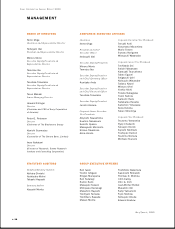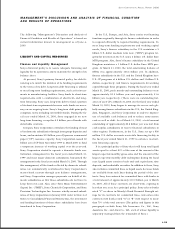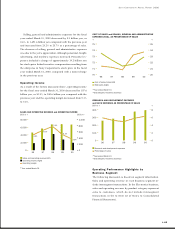Sony 2000 Annual Report Download - page 41
Download and view the complete annual report
Please find page 41 of the 2000 Sony annual report below. You can navigate through the pages in the report by either clicking on the pages listed below, or by using the keyword search tool below to find specific information within the annual report.
SONY CORPORATION ANNUAL REPORT 2000
39
The following “Management’s Discussion and Analysis of
Financial Condition and Results of Operations” is based on
current information known to management as of June 6,
2000.
LIQUIDITY AND CAPITAL RESOURCES
Finance and Liquidity Management
Sony’s financial policy is to assure adequate financing and
liquidity for its operations and to maintain the strength of its
balance sheet.
At present, Sony’s primary financial policy for debt fi-
nancing is to match the duration of its funding requirements
to the terms of its debt. Long-term debt financing is utilized
to meet long-term funding requirements, such as for invest-
ments in manufacturing facilities. Sony funds its short-term
requirements with a combination of short-term and long-
term financing. Sony uses long-term debt to fund a portion
of its short-term requirements because such funds are neces-
sary on an ongoing basis. Sony’s long-term debt principally
comprises notes including convertible bonds. During the fis-
cal year ended March 31, 2000, Sony engaged in no new
long-term financing, except for 4.0 billion yen of bonds with
detachable warrants.
In Japan, Sony Corporation centralizes the funding of most
of its domestic subsidiaries through intra-group deposits and
loans, and maintains 300 billion yen of Japanese commercial
paper (“CP”) issuance capacity. Sony Corporation issued 80
billion yen of CP from November 1999 to March 2000 to fund
a temporary increase of working capital over the year-end.
Sony Corporation started to operate a domestic funds cen-
tralization arrangement in the fiscal year ended March 31,
1999 and most major domestic subsidiaries had joined the
arrangement in the fiscal year ended March 31, 2000. Through
this arrangement, all the funds collected by domestic subsid-
iaries are automatically centralized in Sony Corporation’s
master bank account through zero balance arrangements,
and Sony Corporation arranges payments on behalf of do-
mestic subsidiaries so that those subsidiaries do not have to
keep their own cash. Also, since Sony Music Entertainment
(Japan) Inc. (“SMEJ”), Sony Chemicals Corporation, and Sony
Precision Technologies Inc. became wholly-owned subsid-
iaries of Sony Corporation in January 2000 (refer to Note 4 of
Notes to Consolidated Financial Statements), the investment
and funding functions of those three subsidiaries have been
transferred to Sony Corporation.
MANAGEMENT’S DISCUSSION AND ANALYSIS OF FINANCIAL CONDITION
AND RESULTS OF OPERATIONS
In the U.S., Europe, and Asia, Sony carries out financing
functions regionally through its finance subsidiaries in order
to respond efficiently to regional funding requirements. To
meet long-term funding requirements and working capital
needs, Sony’s finance subsidiary in the U.S. maintains a 3
billion U.S. dollar medium term note (“MTN”) program tar-
geted for investors in the U.S. and a 2 billion U.S. dollar Euro
MTN program. Also, Sony’s finance subsidiary in the United
Kingdom maintains a 1 billion U.S. dollar Euro MTN pro-
gram. At March 31, 2000, the total outstanding balance of
MTNs was approximately 123.6 billion yen. In addition,
finance subsidiaries in the U.S. and the United Kingdom have
U.S. CP programs of 6 billion U.S. dollars and 1 billion U.S.
dollars, respectively, and finance requirements for working
capital through these programs. During the fiscal year ended
March 31, 2000, peak month-end outstanding balances were
approximately 81.3 billion yen and approximately 31.6
billion yen, respectively. (There were no outstanding bal-
ances of such CPs at March 31, 2000.) In the fiscal year ended
March 31, 2000, Sony began to manage its excess cash glo-
bally among finance subsidiaries in the U.S., the United King-
dom, Singapore, and Sony Corporation in order to improve
use of available cash balances and to reduce unnecessary
cash as well as debt. As of March 31, 2000, a total amount
outstanding of approximately 82.8 billion yen was lent from
cash-surplus subsidiaries in Asia to financial subsidiaries in
other regions. Furthermore, in the U.S., Sony set up a 900
million U.S. dollar accounts receivable financing facility in
the fiscal year ended March 31, 1999 to enhance its short-
term financing capacity.
It is a principal policy of Sony that it will keep total liquid
assets equal to at least 80% of the sum of the amount of the
largest expected monthly gross sales and the amount of the
largest expected monthly debt redemption during the fiscal
year. Liquid assets consist of cash and cash equivalents, time
deposits, and marketable securities. In addition to these, Sony
also includes committed lines as liquid assets because funds
are available from such lines during the period of the con-
tracts. Sony has contracts for committed lines with banks in
a total amount of approximately 310.0 billion yen at March
31, 2000. All of those contracts are short-term, expiring in
less than one year. As a principal policy, Sony selects banks
rated “C” or above in Moody’s Bank Financial Strength rat-
ings for its contracts for committed lines, and enters into
contracts with banks rated “A” or “B” with respect to more
than 70% of the total amount. (The policy and figures in this
paragraph exclude Sony Life Insurance Co., Ltd., Sony
Assurance Inc., and Aiwa Co., Ltd., each of whose liquidity is
separately managed from the remainder of Sony.)
























